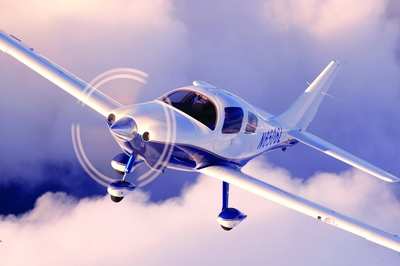Two Fatally Injured In March, 2012, When Cessna Went Into High Rock Lake
A Michigan pilot with strong ties to NASCAR may have been disoriented when the Cessna Columbia 350 (LC42-550FG) he was flying went down in High Rock Lake in North Carolina on March 2, 2012, according to a factual report released by the NTSB. Two people ... pilot Steve Brown and his girlfriend Karyn Martin ... were fatally injured in the accident.

According to the factual report, marginal visual flight rule (MVFR) conditions prevailed, and no flight plan was filed. The flight originated from Davison County Airport (EXX), Lexington, North Carolina, about 1310.
A lineman at EXX stated that he spoke to the pilot prior to departure and the pilot informed him that his destination was Florida. The lineman said that he mentioned the weather to the pilot, and the pilot responded that he was going to stay below 1,900 feet and that he should be fine. Shortly thereafter, the lineman went over to refuel another airplane and heard the pilot announce on the Unicom frequency that he was going to depart runway 24. The lineman watched as the airplane rotated approximately 2,000 feet down the runway and climb out normally. He said that the weather at the time was visual flight rules (VFR) with very light drops of rain. The lineman recalled looking at the Automated Weather Observing System (AWOS) monitor, and it was reporting 1,800-foot ceilings and 10 miles visibility. There were no distress calls made by the pilot or transmissions that the airplane was returning to the airport.
According to FAA, the airplane was not captured on radar at the time of departure. The pilot was not in radio contact with air traffic control at the time of departure and no radio transmissions were recorded. According to witnesses, they heard the airplane flying overhead but did not see it due to heavy fog. The witnesses reported that shortly thereafter, they heard a loud splash in the lake and as they turned towards the direction of the lake, they saw a large spray of water. Shortly thereafter, they saw a large amount of debris in the lake. They believed that it was the airplane that they had just heard and they called the local sheriff's department.

The pilot, age 51, held a private pilot certificate, with ratings for airplane single-engine. The pilot's last FAA medical examination was issued on October 18, 2010, for a third-class medical certificate with limitations for corrective lenses. The pilot reported 271.5 flight hours on his last medical application, and 34 flight hours within the last six months of his exam. A review of the pilot’s logbook revealed a total of 290 flight hours including 174.9 hours of cross country flight time with 120.3 hours in the accident airplane.
There is no record that the pilot obtained an official preflight weather briefing. The AWOS at EXX, located approximately 9 miles north of the accident site at an elevation 733 feet, reported the following conditions surrounding the time of the accident. At the time of departure, the weather observation was: winds calm, visibility 10 statute miles and drizzle, scattered clouds at 1,500 feet, temperature 11 degrees Centigrade (C), dew point 06 degrees C, altimeter 29.98 inches of mercury.
(Cessna Columbia 350 pictured in file photo. Not accident aircraft)
 Bolen Gives Congress a Rare Thumbs-Up
Bolen Gives Congress a Rare Thumbs-Up The SportPlane Resource Guide RETURNS!!!!
The SportPlane Resource Guide RETURNS!!!! Buying Sprees Continue: Textron eAviation Takes On Amazilia Aerospace
Buying Sprees Continue: Textron eAviation Takes On Amazilia Aerospace Hawker 4000 Bizjets Gain Nav System, Data Link STC
Hawker 4000 Bizjets Gain Nav System, Data Link STC Echodyne Gets BVLOS Waiver for AiRanger Aircraft
Echodyne Gets BVLOS Waiver for AiRanger Aircraft




